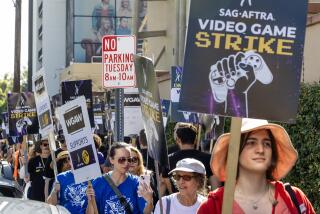NHL players union preparing response to second contract proposal
- Share via
Chief executives of the NHL and the NHL Players’ Assn. met for about 90 minutes on Wednesday to discuss the league’s second labor proposal but were still at odds over the definitions of “hockey-related revenues” and how the NHL would phase in a reduction of players’ salaries over the course of its proposed six-year deal.
Donald Fehr, executive director of the NHLPA, told reporters in New York that the union would deliver a response on Thursday or Friday after it had crunched numbers to determine how individual teams would be affected by the league’s proposed terms.
Fehr and the union’s counsel, his brother, Steve Fehr, met with NHL Commissioner Gary Bettman and Deputy Commissioner Bill Daly at the league’s Manhattan offices. A group of 11 players offered advice to the union negotiators but did not attend the meeting. The Fehrs asked Bettman and Daly questions about various aspects of the league’s proposal.
The current collective bargaining agreement expires on Sept. 15. Bettman has said the league will impose a lockout — the NHL’s third under his watch — if a new agreement is not in place by that date. Training camps are scheduled to open the following week, but several teams have canceled rookie camps and other activities that were scheduled around the time of the labor deal’s expiration.
Fehr said Wednesday the the league’s newly proposed six-year agreement is one year longer than its first proposal. In addition, the second offer pegged players’ salaries in the first year at the equivalent of 46% of revenues, up from 43% in the first proposal.
However, Fehr said the NHL is advocating a narrower definition of hockey-related revenues that would be friendlier to the owners, while the union wants to retain the current definition of hockey-related revenues. Player salaries totaled 57% of hockey-related revenues last season.
The NHL’s proposal doesn’t include a rollback of existing contracts but would result in a significant increase in escrow payments held out of players’ paychecks. The escrow percentage would fluctuate from season to season. The league’s first proposal also included a five-year limit on the duration of contracts and limited free agency to players who had been in the league for 10 years or more.
ALSO:
Replacements in Week 1? NFL is making the wrong call
John Isner survives challenge of foul-mouthed Xavier Malisse
Punchlines fly as Canelo Alvarez trains at Garry Shandling’s gym
More to Read
Go beyond the scoreboard
Get the latest on L.A.'s teams in the daily Sports Report newsletter.
You may occasionally receive promotional content from the Los Angeles Times.











